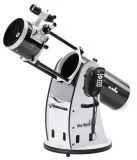- Details
Products description
first review: Solar Spectrum Sundancer 2
With the Baader SunDancer II (with heated H-alpha etalon from SolarSpectrum), any telescope can easily be converted into a professional H-alpha telescope.For a telescope with an aperture of up to 80 mm, no additional accessories are required; only larger apertures require an energy protection filter in front of the lens (e.g., the DERF from Baader Planetarium).
The Sundancer is a completely new development:
It includes an achromatic (!) 3x telecentric lens with a T-2 mount (previously, this had to be attached to a Solar Spectrum H-alpha filter).
The dielectric coating of the blocking filter and SolarSpectrum's hermetically sealed oil-sealed etalon filter prevent the aging processes of simpler filter designs.
It has an automatic heater to set the correct central wavelength.
Fine-tuning of the passband to adapt to different telescope systems is possible via the control box.
Using the micrometer screw, the passband can be easily shifted to the blue wing of the H-alpha line to compensate for the Doppler effect during fast H-alpha events on the Sun.
We had the opportunity to get one of the first units, and I tested it immediately (somehow, this one wasn't the typical two weeks of rain that usually occur when buying new astronomical equipment).
Additionally, I compared my PST40, which I slightly modified (Stage 1 modification), with the Sundancer 2.
Test Setup
The Skywatcher AZ-EP6 Pro mount was chosen, and two Skywatcher Evostar 120 telescopes were used, one of which was shortened to allow the PST40 to be correctly positioned in front of the primary focus. The rear (left) telescope is equipped with the Sundancer 2, and the front telescope is equipped with the PST40mod. Since I only have one DERF on hand, I swap it for each test. Of course, the telescope is rotated out of the sun for this purpose.
First conclusion - visual
The 3x telecentric lens increases the focal length of the Evostar to 3000 mm, which naturally results in significantly greater magnification. By slightly increasing the temperature (by 1.4 °C), the prominences and the surface were immediately sharp and clearly visible. The entire sun would only be visible with a telescope focal length of 600 mm; however, I like the detailed images and am always happy when new events appear while scrolling across the solar surface.
In comparison, the PST40 also performs very well. Visually, both systems show the solar surface and the prominences sharply. The "sweet spot" (or Jaquinot spot), typical of the PST40, is barely noticeable. The image in the PST40 is smaller, but visually very beautiful.
First photographic tests
Setup: Evostar 120 (original), DERF 110 mm, Solar Spectrum Sundancer 2, ZWO ASI 178 at primary focus
The superimposed pattern is from the ZWO ASI 178, which tends to produce an interference pattern in monochrome images. However, this can be removed using flat-frame processing. Here, you can see vignetting (whether it's caused by the eyepiece projection, I still have to determine) and the sweet spot area in the upper section.
Weitere Tests folgen…
Pictures: See german Version
This Product was added to our catalogue on 18/09/2021.
Categories
Quick purchase
Welcome back!
Last viewed:
Manufacturer
Shipping country


